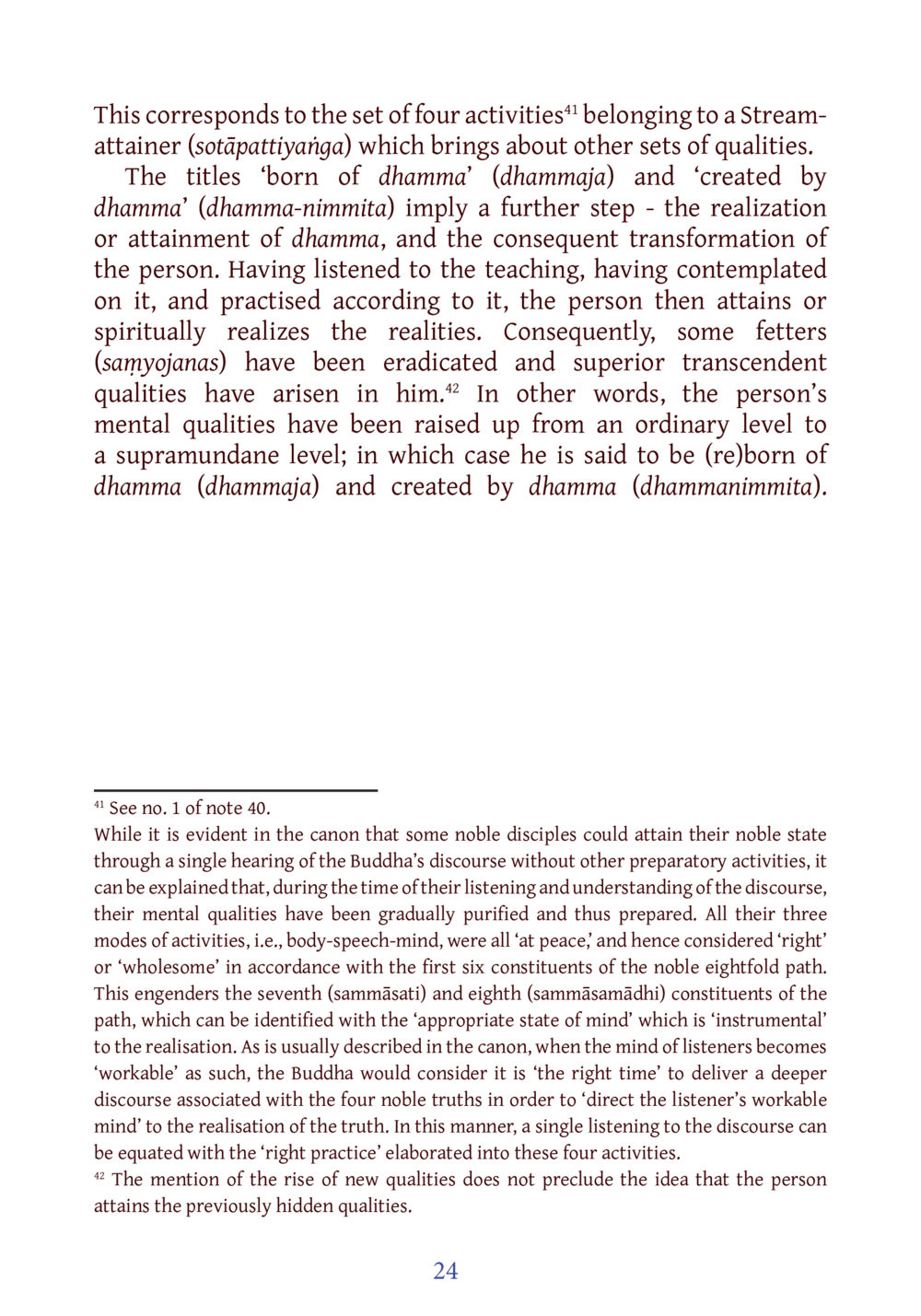Understanding Dhamma and Spiritual Realization : หน้า 45/141
DIRI Journal : หน้า 45/141 Explore the transformative process of attaining dhamma and the emergence of superior qualities in individuals through teachings and practices.
3 ครั้ง

สรุปเนื้อหา
This content discusses the process of spiritual attainment through dhamma, emphasizing four key activities that lead to the emergence of noble qualities. It highlights how listening to the Buddha's teachings can purify the mind and facilitate realization of the truths, while also considering the importance of mental readiness and the interplay of body, speech, and mind in achieving a higher state of being.
หัวข้อประเด็น
-spiritual attainment
-mental purification
-Buddha's teachings
-superior qualities
-noble eightfold path
ข้อความต้นฉบับในหน้า
This corresponds to the set of four activities41 belonging to a Stream-attainer (sotāpattiyānga) which brings about other sets of qualities.
The titles ‘born of dhamma’ (dhammaja) and ‘created by dhamma’ (dhamma-nimmita) imply a further step - the realization or attainment of dhamma, and the consequent transformation of the person. Having listened to the teaching, having contemplated on it, and practised according to it, the person then attains or spiritually realizes the realities. Consequently, some fetters (samyojanas) have been eradicated and superior transcendent qualities have arisen in him.42 In other words, the person’s mental qualities have been raised up from an ordinary level to a supramundane level; in which case he is said to be (re)born of dhamma (dhammaja) and created by dhamma (dhamma-nimmita).
41 See no. 1 of note 40.
While it is evident in the canon that some noble disciples could attain their noble state through a single hearing of the Buddha’s discourse without other preparatory activities, it can be explained that, during the time of their listening and understanding of the discourse, their mental qualities have been gradually purified and thus prepared. All their three modes of activities, i.e., body-speech-mind, were all ‘at peace,’ and hence considered ‘right’ or ‘wholesome’ in accordance with the first six constituents of the noble eightfold path. This engenders the seventh (sammāsati) and eighth (sammāsamādhī) constituents of the path, which can be identified with the ‘appropriate state of mind’ which is ‘instrumental’ to the realisation. As is usually described in the canon, when the mind of listeners becomes ‘workable’ as such, the Buddha would consider it is ‘the right time’ to deliver a deeper discourse associated with the four noble truths in order to ‘direct the listener’s workable mind’ to the realisation of the truth. In this manner, a single listening to the discourse can be equated with the ‘right practice’ elaborated into these four activities.
42 The mention of the rise of new qualities does not preclude the idea that the person attains the previously hidden qualities.
หน้าหนังสือทั้งหมด

1

2

3

4

5

6

7

8

9

10

11

12

13

14

15

16

17

18

19

20

21

22

23

24

25

26

27

28

29

30

31

32

33

34

35

36

37

38

39

40

41

42

43

44

45

46

47

48

49

50

51

52

53

54

55

56

57

58

59

60

61

62

63

64

65

66

67

68

69

70

71

72

73

74

75

76

77

78

79

80

81

82

83

84

85

86

87

88

89

90

91

92

93

94

95

96

97

98

99

100

101

102

103

104

105

106

107

108

109

110

111

112

113

114

115

116

117

118

119

120

121

122

123

124

125

126

127

128

129

130

131

132

133

134

135

136

137

138

139

140

141
หนังสือที่เกี่ยวข้อง
Load More
